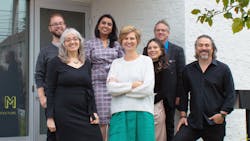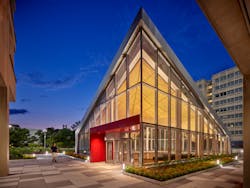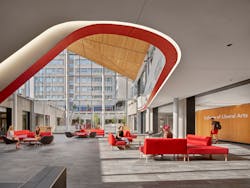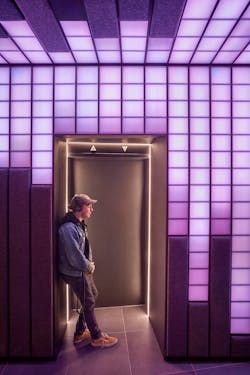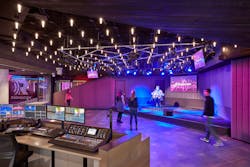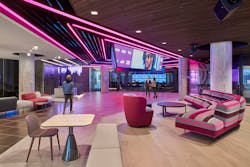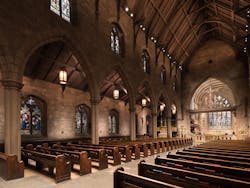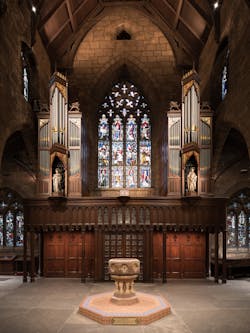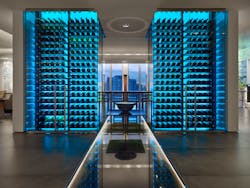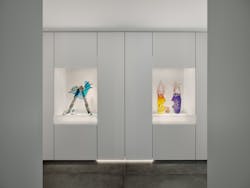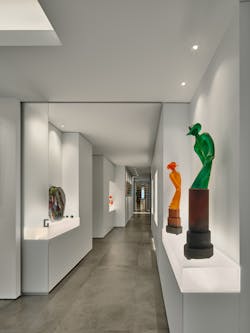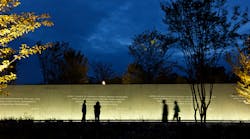For Architectural SSL’s inaugural Designer Files feature, we head to our nation’s first capital, Philadelphia, to feature design studio BEAM, ltd. Established in 2002, the women-owned firm selected its name for its ability to be both an architectural and lighting element—a fitting analogy to its co-founders, registered architect Kirsten Kent Carangi and lighting designer Adam Carangi, LC, MIES. Kirsten earned her B.Arch. from North Dakota State University and has been practicing since 1993; Adam graduated from nearby Temple University with a B.A. and has been practicing since 1999.
They lead their eight-person studio alongside senior lighting designers Christina Spangler and Jeffrey Kahn. Together, they share more about their firm’s approach and several key projects.
Firm objective: We are true collaborators of design. Our clients enjoy working with our designers. We are a small but nimble firm that meets all deadlines and has the knowledge to communicate our designs. Knowing how to use light to enhance the architecture, understanding the latest fixture technologies and state of the construction market, and being excellent communicators give BEAM a competitive edge.
First commission: After consulting on smaller projects, we won our first commission to illuminate the historic Christ Church Philadelphia. Dating to 1744, this church was standing when the Declaration of Independence and Constitution were being authored just blocks away. The building was the tallest in North America for 54 years due to its steeple, which had never been illuminated, inside or outside.
After we successfully illuminated the steeple, our commission was extended to the interior. We added electrified replicas of candelabra sconces, highlighted the organ, and designed a specialized lift to lower a chandelier once gifted to Benjamin Franklin’s daughter on her wedding to accommodate the installation of new candles for each event.
Favorite project by our company: Doing something simple for maximum effect can be satisfying, especially when it comes to architectural lighting. One favorite is the PhillyCAM Façade, a simple project featuring a sawtooth façade pasted with a graphic mix of colored geometric squares reminiscent of CRT television fuzz—except this fuzz was painted and fixed. Using a simple RGBW flood light scrolling through different colors of light, we made the façade look animated. It was basically a study in color science as some colors disappeared when the light changed hue. We created an enchanting effect within a budget that could not afford a pixelated sign.
Second favorite project: The headquarters of Entercom Communications Corp. (now known as Audacy), one of the country’s largest radio and media companies, had a diverse program, including offices, recording and production studios, and performance spaces. Our design team blended practical as well as playful spaces that included sound- and motion-activated lighting design as well as lighting suited for performance, on-air video broadcast, or simple in-house meetings. Overall, the project was complex, but it brought incredible flexibility with tremendous design.
What we are known for: BEAM is known first and foremost for its client collaboration. Since the firm’s inception, our goal was to ensure the lighting design complements the architecture and meets the needs of the users of the space.
What people don’t know about us: Our firm’s level of expertise and experience is often overlooked. In our 21-year history, we have completed well over 1,100 projects. Our two most senior designers each have more than 25 years’ experience in architectural lighting. Our principal has 30 years of experience. The remainder of our team collectively adds more than 30 years of experience in lighting design and in adjacent fields.
Our firm culture: Everyone is cross-trained to learn all aspects of the project, from proposal to final punch list. Our hierarchy is based on experience and expertise only, where someone with less overall experience may lead a portion of the project based on their expertise. We have a teamwork mindset: When deadlines are critical, the team rises to complete the project for our clients. We also work hard to ensure a quality work–life balance, which should be integral to any business.
Favorite design move: Our only design move is to avoid the lighting industry’s most popular and trendy design moves. Lighting is fashion, and we prefer to give our clients a solution that doesn’t necessarily follow the latest fashion, but offers originality beyond the trend. Not every project calls for color-changing luminaires or the ubiquitous “linear slot of light” to make a design feel contemporary.
Lighting project type you’d like to pursue one day: Large-scale public space with a prominent, dynamic lighting feature. Lighting can completely transform an underutilized outdoor space into an evening destination. It is fascinating to watch people of all ages interact with the lighting, from children dancing among patterns of light and shadow to teens capturing an Instagram moment, or to couples enjoying their time in a magical space.
Industry generalization or perception that should be debunked: Lighting designers are only needed for the important spaces of a project because they cost too much otherwise. Not true! An architect can benefit from using a lighting designer for many reasons, including better design, better energy efficiency, higher probability of achieving WELL or LEED certification, and ultimately, to develop a better overall finished project.
Top industry concern today: The lack of lighting designers entering and staying in the profession. A large percentage of lighting designers eventually move into manufacturing or product sales due to financial constraints. We have that concern at our firm, but we run an excellent design practice with benefits.
A lighting trend that needs to return: Appropriate design. Light can be lively and fun, make a statement, or be majestic and monumental. Applying light to an object or space is an honor and should be approached with respect. We are experienced professionals asked to make thoughtful lighting recommendations. Whereas a flamboyant lighting style can be delightful and fun, it is not appropriate for every project. In addition to being technical wizards of light, we need to educate our clients that lighting creates a powerful aesthetic and has a tremendous impact on the wider community.
A lighting trend to leave behind: Throw-away luminaires. Luminaires need to be more easily maintained and have LEDs that can be replaced. Too many luminaires are built to be recessed with housings or mounting plates, meaning their “end of life” replacement requires an unacceptable amount of work and investment. LEDs have done wonders to reduce our electricity consumption. In the era of the disposable flat panel luminaire and inaccessible micro apertures, are we considering the energy required to produce each new, replacement luminaire? How can a manufacturer be incentivized to take back the mechanical components and reuse them for the next batch?
Also: Luminaires with selectable output, color, or other features. This could be a good idea, but could do more harm than good to the lighting design.
Lighting aggravation: “Or equal” or “guaranteed approved” fixtures—either on paper, in the bid process, or as substituted fixtures installed on-site that will never perform as the designer intended or, importantly, as the owner may have wanted.
Designers you admire: Tadao Ando, John Pawson, James Carpenter, Rick Joy, Claudio Silvestrin, Louis Kahn, and SHoP Architects
Must-see city or place for any lighting designer: Any James Turrell Skyspace. We are lucky to have a Skyspace installation near our studio, but it should be a destination goal for anyone in the lighting business. There, you will get a firsthand experience of the eye and brain connection, and how tenuous our perception of reality is.
Advice to anyone interested in entering the lighting industry: Keep working toward visceral lighting fluency. Take any and every opportunity to hold a working luminaire. Move it around. Aim it at different angles on the same object. Change the optics and experience the variation. Take note of the quality of light, how it changes, and what changes it. Understanding the science of light is fundamental, but not until the effects of light become intuitive can lighting become the medium of your art.
This profile was edited by Wanda Lau.
